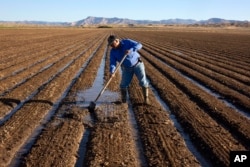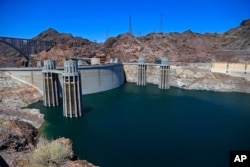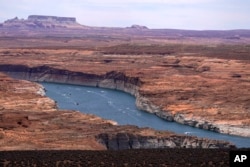The U.S. government plans to reduce the amount of Colorado River water several states are permitted to use next year.
The river supplies water to seven Western states, more than 20 Native American tribes, and two states in Mexico.
Those states and the country of Mexico are also considering plans for how to share the water after 2026. That is when many current rules and agreements about the use of Colorado River water will come to an end.
The river brings water to millions of hectares of farmland in the American West. Hydroelectric dams on the river produce power. Experts say increased water use, combined with rising temperatures and dry weather, are the reasons for the need to make cuts.
In 2007, following years of dry weather, the U.S. states in the river’s basin and the federal government agreed to rules to help deal with lower water levels. The states involved were Arizona, Nevada, California, Colorado, New Mexico, Utah and Wyoming.
Those rules determine when some of the states must cut their water usage based on levels at Lake Mead. The lake is on the border of Nevada and Arizona. It provides water for hydropower, farming, and other needs.
Because of the need for new rules, states, Native American tribes, and others are forming new plans to deal with even deeper water cuts that might happen in 2026.
The federal government will announce water cuts for 2025 based on levels at Lake Mead. If Lake Mead drops below a level that has been agreed to, Arizona, California, Nevada and Mexico will face cuts. However, California might not face cuts because the current rules give that state special water rights.
Last year, Arizona, California and Nevada agreed to save an extra 3 million acre-feet of water in addition to the cuts the federal government had already required. An “acre-foot” is equal to about 1.2 million liters. In return, the U.S. government agreed to pay water districts and other users for much of that reduction in water use.
Colorado, New Mexico, Utah and Wyoming are in the river’s Upper Basin. Those states have not used all of the water the rules permit them to use. For this reason, they have not yet had to reduce the amount of water they take from the river.
Wet weather in 2023 and efforts to save water by Lower Basin states have increased the level of Lake Mead and Lake Powell. Lake Powell in Utah is another body of water that holds and releases water from the river.
However, experts say higher temperatures will continue to reduce water in the Colorado River in the coming years.
In March, Upper and Lower Basin states, tribes and environmental groups proposed plans to deal with likely water reductions in the future.
Arizona, California and Nevada asked the federal government to include water levels at other reservoirs besides Lake Mead and Lake Powell. Their plan says that if the whole system drops below 38 percent of the maximum amount of water it can hold, the Upper Basin and Mexico should share deeper cuts equally with the Lower Basin.
Colorado, New Mexico, Utah and Wyoming want larger and sooner cuts when water is low at Lake Mead and Lake Powell. The cuts would affect California, Arizona and Nevada. Their plan does not call for reductions in how much water Upper Basin states use.
The federal government is expected to propose new rules by December. The rules would consider the different plans and possible steps for the future. Until then, states, tribes and other groups will continue negotiations on water.
I’m Andrew Smith. And I'm Anna Matteo.
Suman Naishadham wrote this story for The Associated Press. Andrew Smith adapted it for VOA Learning English.
________________________________________________
Words in This Story
basin –n. the area drained by a river
determine –v. to officially decide
acre-feet –n. a measure of volume used specifically in the United States for large-scale water use which is equal to about 1.2 million liters
district –n. a special area created by a government for a special purpose
reservoir –n. a body of water usually formed by a dam that is meant to be used as a water supply















Forum